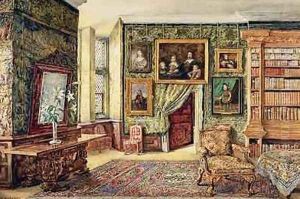W. Nicholson Paintings
Sir William Newzam Prior Nicholson was an English painter, also known for his work as a wood-engraver, illustrator and author of children's books. Born on February 5, 1872, in Newark-on-Trent, Nottinghamshire, Nicholson was a son of William Newzam Nicholson, an industrialist and Conservative MP of Newark. Nicholson showed early promise in art and attended Hubert von Herkomer's art school, where he met his lifelong friend and future brother-in-law, James Pryde. Together, they formed a partnership known as the 'Beggarstaff Brothers', collaborating on poster designs that were revolutionary in their graphic simplicity and use of negative space.
Nicholson's work spans a variety of media and styles, from woodcut printmaking to portrait painting. In the 1890s, his woodcut prints of subjects like 'An Alphabet' and 'An Almanac of Twelve Sports' were innovative in their departure from the highly decorative styles of the time, presenting a more modern, pared-down aesthetic. This work gained him recognition and set the stage for his later achievements as a painter. Nicholson's painting style evolved over the years, beginning with Impressionist influences and moving towards a more realist approach. His portraits and still lifes are particularly noted for their simple elegance and clarity of form.
In the early 20th century, Nicholson's focus shifted to painting. He became well-known for his portraits, creating likenesses of famous figures such as the poet Rudyard Kipling and the playwright George Bernard Shaw. His landscape and still-life paintings exhibited a distinctive use of color and light, capturing the essence of his subjects with both subtlety and strength. During World War I, he served in the British War Propaganda Bureau, creating images designed to boost morale and support the war effort.
Apart from his visual art, Nicholson also illustrated books, such as an edition of 'The Velveteen Rabbit' by Margery Williams and wrote and illustrated his own children's books. His contributions to art were recognized in his lifetime; in 1936, he was knighted for services to art.
Nicholson's personal life was marked by his marriage to Mabel Pryde, a Scottish painter and sister of James Pryde, with whom he had four children, including the artist Ben Nicholson. He later married Edie Stuart Wortley with whom he had three more children. Nicholson's family was artistically inclined, with his children Ben, Nancy, and Tony also gaining recognition in the arts.
Sir William Nicholson passed away on May 16, 1949, in Blewbury, Berkshire. Today, his work is held in high regard and can be found in many major collections, including the Tate Gallery and the National Portrait Gallery in London. Nicholson's legacy as an artist is characterized by his versatility, his innovative approach to printmaking, and his influential contributions to the visual arts of the early 20th century.
